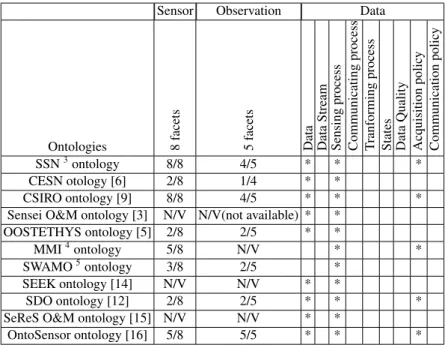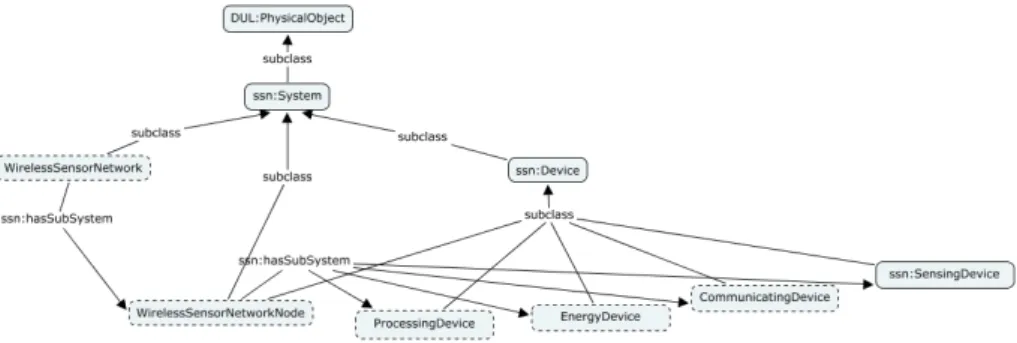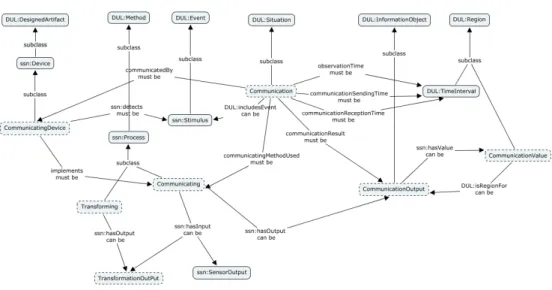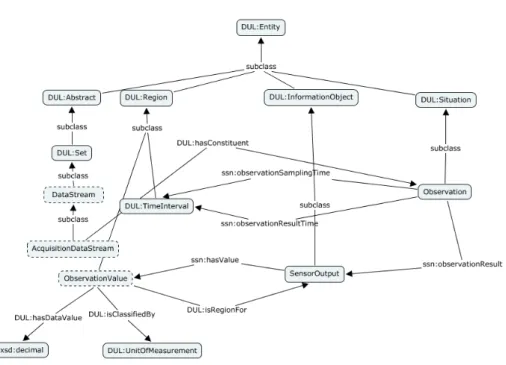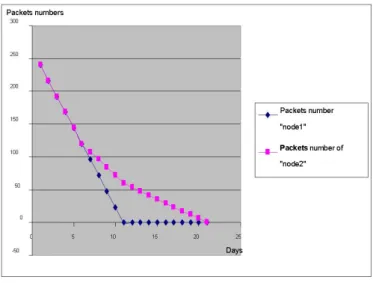HAL Id: hal-00819301
https://hal.archives-ouvertes.fr/hal-00819301
Submitted on 30 Apr 2013
HAL is a multi-disciplinary open access
archive for the deposit and dissemination of
sci-entific research documents, whether they are
pub-lished or not. The documents may come from
teaching and research institutions in France or
abroad, or from public or private research centers.
L’archive ouverte pluridisciplinaire HAL, est
destinée au dépôt et à la diffusion de documents
scientifiques de niveau recherche, publiés ou non,
émanant des établissements d’enseignement et de
recherche français ou étrangers, des laboratoires
publics ou privés.
R. Bendadouche, Catherine Roussey, G. de Sousa, J.P. Chanet, K.M. Hou
To cite this version:
R. Bendadouche, Catherine Roussey, G. de Sousa, J.P. Chanet, K.M. Hou. Extension of the Semantic
Sensor Network Ontology for Wireless Sensor Networks: The Stimulus-WSNnode-Communication
Pattern. 5th International Workshop on Semantic Sensor Networks in conjunction with the 11th
International Semantic Web Conference ( ISWC), Nov 2012, Boston, United States. 16 p.
�hal-00819301�
Extension of the Semantic Sensor Network Ontology for
Wireless Sensor Networks:
The Stimulus-WSNnode-Communication Pattern
Rimel Bendadouche1, Catherine Roussey1, Gil De Sousa1, Jean-Pierre Chanet1, and
Kun Mean Hou2
1 Irstea, National Research Institute of Science and Technology for Environment and
Agriculture
{rimel.bendadouche,catherine.roussey,gil.de-sousa, jean-pierre.chanet}@irstea.fr
2
LIMOS, Laboratoire Informatique, Mod´elisation et Optimisation des Syst`emes kun-mean.hou@isima.fr
Abstract. Wireless Sensor Networks (WSN) are designed to collect large amounts of heterogeneous data to monitor environmental phenomenon. Our aim is to adapt WSN nodes communication to their context, in order to optimize the lifetime of the network. Our description of context and WSN characteristics are based on on-tologies. Based upon a critical analysis of existing ontologies which formalize the WSN domain, we determine that the Semantic Sensor Network (SSN) ontology is the most suitable to represent the WSN issues. However, as the communication data policy is not characterized either by SSN or by other ontologies, we pro-pose to enrich the SSN ontology with a new pattern describing communication. In this paper, we will first integrate the different concepts related to WSN in the SSN ontology and then we will use the resulting ontology, called Wireless Se-mantic Sensor Network ontology, in an agri-environmental scenario to illustrate the interest of our approach.
1
Introduction
In recent decades, thanks to the advance of embedded systems and wireless technolo-gies, Wireless Sensor Network (WSN) becomes widely used. WSN usually consists of a set of wireless sensors nodes (from a few tens to a few hundreds), which acquire, store, transform and communicate data using wireless technologies [1]. The development of WSN is motivated by several systems such as military monitoring system, smart home system, etc.
Our work focuses particularly on agri-environmental applications. A WSN can im-prove the knowledge of the environment and the effectiveness of management methods for instance in our case to prevent flooding. In this application, the WSN collects large amounts of heterogeneous data (rainfalls, temperatures, water levels, etc.). This work aims to integrate into an information system these data in an optimal way.
However, by its nature, the WSN nodes are characterized by limited resources: en-ergy, computing power and storage capacity. In this kind of network, energy is the main
constraint that limits the rendered services by each node. Knowing that communication is the most energy-consuming service, the WSN nodes should limit the communication of their data as much as possible to increase their lifetime. That is why the communica-tion data policy may be very different from the acquisicommunica-tion one. Even when two nodes are parameterized with the same acquisition policy, their communication policy can be very different depending on their resources available. WSN nodes with enough energy could communicate all their acquired data with the same frequency as the acquisition one. On the contrary, WSN nodes that have a low energy level would communicate, for example, just an aggregate value (max, min, etc.) with a lower frequency than the acquisition one. Thus, the communicated data of these nodes are different even if the same kind of data is acquired.
Therefore, WSN nodes must be able to adapt to their context (for example, their energy level). The context is a set of information that the node may have on its environ-ment. A node takes into account its context to improve its lifetime and consequently the overall functioning of the network. Ontologies are a solution to describe the sensors, their data and their context. They also define metadata vocabularies. Through ontolo-gies, it will be possible to assign to the data a description of its acquisition and com-munication policies in order to enhance the integration of the sensor data. Moreover, by using semantic rules, ontologies are also components of reasoning systems. So we can also use them to develop an intelligent system able to modify the nodes’ behaviour to optimize their lifetime and, by extension, WSN lifetime. In our case, ontologies have two objectives: defining metadata about WSN or observation of phenomenon and defin-ing the knowledge needed for reasondefin-ing purposes.
In the literature, several sensor ontologies are developed in different domains. In this paper, we will illustrate how we can use these ontologies to describe WSN con-cepts. The remainder of this paper is organized as follows. Section 2 details our needs and defines several concepts related to acquisition and communication policies. Section 3 presents a state of the art about sensor ontologies. Our critical review highlights that the SSN ontology is the most suitable to describe WSN topics. However, this ontol-ogy ignores the communication process of the sensor data. After a brief presentation of some parts of SSN ontology, section 4 gives our proposition of a extension of this ontology called Wireless Semantic Sensor Network ontology (WSSN). Section 5 illus-trates the use of WSSN ontology in agri-environmental scenario with JADE platform. This experiments evaluate the improvement of the lifetime of WSN nodes using our approach.
2
Description of our Needs
WSN are largely used to collect data of various domains (agri-environmental, military, etc). In our work we are interesting in agri-environmental applications using Decision Support System (DSS) to anticipate environmental risks. Before presenting our needs, we will present our use case: the monitoring of flooding in a watershed using a WSN that provides data to a dedicated DSS. A watershed is an extent or an area of land where surface water from rain, melting snow or ice converges to a single point, usually the outlet of the basin and joins another waterbody, such as a river, lake, reservoir,
es-tuary, wetland, sea, or ocean. In case of heavy rain, the DSS evaluates and predicts the flooding risks in the outlet of the basin. The system needs WSN to monitor the amount of rainfall (precipitation) during a given time interval at the top of mountains and hills in the watershed. This precipitation measure is carried out through a pluviometer. When it rains, the WSN performs the precipitation measurement every hour. If the rain persists, the WSN changes its communication policy and sends measurements every minute for a better monitoring of the phenomenon. Then, if the precipitation quantity exceeds a threshold, the DSS requests water level measures of the outlet and the different wa-terbodies that feed the basin. Then, the WSN sends these measurements. The flood phenomena can be modelled by the succession of four states:
– “Normal”, when it does not rain;
– “Waiting for rise in water levels ”, when it rains;
– “Rise in water levels”, when the rain persists and a certain amounts of precipitation fall;
– “Flood warning”, when the water level of the outlet and waterbodies exceed a threshold.
The current state of the observed phenomenon can be deduced from WSN measure-ments, the acquired data. For example, if the total rainfall on the watershed exceeds a certain threshold, then the flood phenomenon changes from ”normal” to the second state “Rise in water levels”. Thus, acquisition and communication data policies of a WSN node reflect both the current node state (for example, the node energy level) and the phenomenon state. All of these state changes can be performed by a rule-based sys-tem which is a type of expert syssys-tems. The reasoning can be modelled using decision rules applied to a set of facts. Indeed, some types of ontologies define entities used in rule-based engine. In this scenario, WSN node should:
1. interoperates with other nodes;
2. reasons to be able to adapt to its context: the wireless sensor node state and the observed phenomenon state;
3. changes intelligently its acquisition and communication data policies under the su-pervision of both the network and the DSS.
In the following, we assume the definition of the ”context” notion based on “state” one:
State: ”The state is a qualitative data which changes over time, summarizing a set of information.”
Context: ”The context is a set of entities states or information describing an envi-ronment where an event occurs”.
Ontologies as metadata vocabularies will allow to describe the sensor data, define the node state and the phenomena state. In our work, we use ontologies to meet several needs:
– Normalize the WSN vocabulary. This vocabulary will define concepts relating to: • Composition of WSN and their settings: node, sensor, energy device, etc.
• Acquisition of the measure: stimulus, measure, observed phenomena, acquisi-tion policy, etc.
• Data communication: data types, aggregation data type, data stream, commu-nication policy, etc.
– Define message formats using the previous vocabulary for building acquisition and communication data stream. The messages will contain some information about node state.
– Model the knowledge used in rules engines. The ontology will help to formalize the facts used by the rules. Two rules engines are needed. The first one is dedicated to deduce the state changes of the observed phenomenon from the data provided by WSN. The second engine adapts the WSN node acquisition and communication policies based on the state of the observed phenomenon and the state of the node. It also deduces the state of the node based on its energy level.
In summary, our ontology should allow us to normalize a metadata vocabulary used to describe the WSN and its components. These metadata will describe sensors data and the measuring process of their measures. The ontology will also define the data exchange format for describing data stream. Finally, it will also support the intelligence of the WSN node, the WSN and the DSS. It should be used in a rule-based system to infer new data (according to the state of the WSN nodes and the observed phenomenon) an control WSN behaviour by optimizing data communications. In the literature, several sensor ontologies fulfil part of these different needs. In order to find the most suitable ontology to our purposes, we present in the next section an overview of these ontologies.
3
State of the Art
In our scenario, our ontology should describe 3 topics: “1: Sensor topic”, the WSN and its components; “2 Observation topic”, the measurement process; “3 Data topic”, processes using data like aggregation or communication processes. In the literature, several state-of-art address the sensor ontologies topics issue such as in [4] and [7].
Inspired by this latest review [7], which has analyzed in details sensor ontologies with the two first topics previously mentioned: ’Sensor’ and ’Observation’, our work analysed these ontologies focusing on the third topic – the ’Data topic’, as reviewed in [4].
Data: a third topic that ontology can describe is the sensor data. The data is the result obtained by an observation which may be transformed, stored and communicated to the DSS. In this topic, we are interested in all the processes using this data, as trans-forming and communicating, and generated data stream (set of data). Ontologies that integrate this topic tend to describe the data generated by the sensor network. They should describe the acquired and communicated data.
In Table 1, the presence/lack of the symbol (*) identifies the ability/inability of the ontology to describe the related topic. However, for the two first topics we attribute a percentage of the facets which are described by the ontology. For example SSN on-tology has 8/8 sensor facets, it means that SSN onon-tology describe all the facets of the sensor topic.
Sensor Observation Data
Ontologies 8facets 5facets Data Data
Stream Sensing process Communicating process T ranforming process States Data Quality Acquisition polic y Communication polic y SSN3ontology 8/8 4/5 * * * CESN otology [6] 2/8 1/4 * * CSIRO ontology [9] 8/8 4/5 * * * Sensei O&M ontology [3] N/V N/V(not available) * *
OOSTETHYS ontology [5] 2/8 2/5 * *
MMI4ontology 5/8 N/V * * SWAMO5ontology 3/8 2/5 *
SEEK ontology [14] N/V N/V * *
SDO ontology [12] 2/8 2/5 * * * SeReS O&M ontology [15] N/V N/V * *
OntoSensor ontology [16] 5/8 5/5 * * * Table 1: Review on sensor, observation and data ontologies
According to the analysis made by the authors in [7] and Table 1, it can be noted that in one hand, CSIRO and SSN are the best ontologies to represent the first topic ’Sensor’, and on the other hand, CSIRO, SSN, SDO and Ontosensor ontologies are best suited to represent Observation topic.
Data: SDO ontology is an example of such ontologies, it gives just a simple classi-fication of sensor data. In SSN ontology, the data generated by the sensor are associated to SensorOutPut class and their values to the observationValue one. However, none of the ontologies previously mentioned, describes data stream and their characteristics, especially the communication of data acquired by sensors. For processes using data, only the sensing process is described by the 11 sensor ontologies. However none of these ontologies describes the communicating and the transforming processes. Accord-ing to our state of art, none of these ontologies describes completely these three topics: Sensor, Observation and Data. However, SSN ontology, which integrates several on-tologies as CSIRO, models very well the two first topics. Hence we prefer to improve this ontology rather than developing a new one. Knowing that communication is the most energy-consuming process of the WSN node, we integrate it in the SSN ontology. In order to enrich SSN ontology, WSN concepts will be described in the next sec-tion.
3
http://www.w3.org/2005/Incubator/ssn/XGR-ssn-20110628/.
4
Marine Metadata Interoperability, MMI Device Ontology: A Community Development Project.
5
4
Extension of the SSN Ontology
SSN ontology was created by the W3C Semantic Sensor Network Incubator Group (The SSN-XG). One of the main objectives of this group is the development of ontolo-gies that describe sensors and sensor networks for web applications. According to their review of sensor ontologies, the group has classified these ontologies in two categories: sensor topic and observation topic. The SSN ontology integrates these two topics in a single ontology and is based on the Stimulus-Sensor-Observation ontology design pat-tern. This pattern is specialized to cover sensor key concepts. In order to facilitate its evolution, SSN was built in a modular way and presents in [8] an overview of modules. For example, the main classes are: device, observation, feature of interest, sensing pro-cess, deployment, platform and measurement capability. The SSN ontology covers the general aspect of sensing applications and by specializing this ontology it is possible to describe some key concepts of WSN domain. However, SSN ontology does not focus on the communication process and new classes related to this process and to data pro-cessing are needed. So, to integrate all aspects of WSN domain, we have to describe the following points:
– WSN node devices: the SSN module “Device” does not contain all devices that a WSN node can have.
– Communication: the SSN ontology ignores the communication process of acquired data. However, this ontology describes precisely the acquisition process.
– Data stream: we want to differentiate at least two data stream involved in WSN. • Acquisitional Data Stream: data stream produced by the sensors of a WSN
node.
• Communication Data Stream: data stream communicated by the communicat-ing device of a WSN node.
– State: in our approach, the WSN node will adapt its behaviour to its context com-posed of the phenomenon state and its own state. Thus, we need to define the WSN node states to optimize the network resources.
Notation: Most of the figures describing the ontology and the examples have been created with the help of the Concept-map (CMAP) Ontology Editor (or COE). In this figures, the new WSSN classes are presented with dotted shape.
4.1 WSN Node Devices
A Wireless Sensor Network (WSN) consists of a set of small entities called WSN nodes. These nodes have limited energy resources, memory and computing capacities. They communicate with each other using wireless technologies such as IEEE 802.15.4 (Zig-Bee) [1]. A WSN node is composed of several devices like the communicating device and the sensing device. The sensing device, also named sensor, measures the property of a feature of interest. In the SSN ontology, a SensingDevice is a Device, a specialization of System. A system is composed of several subsystems. Thus, a sensing system may be composed of several devices like battery and sensor. A sensing device is characterized
by some measurement capability and measurement property as accuracy or precision. In WSSN ontology, a WirelessSensorNetworkNode is composed of four devices: Pro-cessingDevice, CommunicatingDevice, EnergyDevice and ssn:SensingDevice as shown in the Figure 1. A communicating device will also have some communication capability and communication property as frequency and bandwidth. A WirelessSensorNetwork is also a system composed of several WirelessSensorNetworkNodes.
Fig. 1: Wireless Sensor Network (WSN)
The sensing device acquires a data. The processing device produces a new data, that can be an aggregation of a set of acquired data. The communicating device communi-cates a data acquired by the sensing device or produced by the processing device. In the next section, we present the communication process.
4.2 Communication Process
The SSN ontology is based on Stimulus-Sensor-Observation Ontology Design Pattern (ODP) proposed by [13]. This pattern, presented in Figure 2, describes the measure-ment process centered around the notions of stimuli, sensor and observations. How-ever, to highlight this communication process, we need another pattern: the Stimulus-WSNnode-Communication ODP which describes this process. This new pattern is pre-sented in the next section.
Stimulus: Stimuli are the starting point of any process as they act as triggers for sensors or communicating devices. A stimulus can be a detectable change in the observed phe-nomena which act as an unintentional stimulus for sensing process. It could also be an incomming communicating request which act as an intentional stimulus for communi-cating process.
Sensor (SensingDevice): Sensors are physical objects that perform observations, i.e., they transform an incoming stimulus into another, often digital representation.
CommunicationDevice: Communicating Devices are physical objects that perform com-munications of data acquired by sensors.
device) and output of the sensor. Therefore, observations are social, not physical, ob-jects. They define the context of the measurement process. For example, they can fix parameters such as time and location.
Communication: Communications act as a nexus between incoming stimuli, communi-cating device and output of this device. Like observations, communications are social objects. They define the context of communication processes of data acquired by sen-sors during observations.
Procedure: Procedure is a description of how a device works, i.e., how a certain type of stimuli is used to produce a digital representation: a data output of the associated process.
Sensing: Sensing is a description of how the sensing device works. It represents the measurement process.
Communicating: Communicating is a description of how the communicating device works. It represents the communication process.
SensorOutPut: Sensor output is the result of the observation: a data acquired by sensor. It is a symbol representing a value.
CommunicationOutPut: Communication output is the result of the communication: a data transmitted by the communicating device. A communicated data can be equal to a data acquired by sensor or to a data generated from a set of data acquired by sensors using some aggregation procedure for example.
We notice that an observation may be followed by a communication and a commu-nication should precede an observation. The link between observation and communi-cation is realized by the properties hasObservation and hasCommunicommuni-cation. A commu-nication may associate to several observations if the communicated data correspond to the aggregation of data acquired during several observations.
Aligning the Stimulus-WSN node-Communication ODP with DUL To ease the in-tegration of this new ODP in the SSN ontology this pattern has been aligned to the ultra light version of the DOLCE foundational ontology (DUL) and refined to match the content of the SSN ontology. Figure 3 presents the result of this integration.
The class Communication in the WSSN ontology provides the structure to represent a single communication. A communication is a situation that describes a communicat-ing device, a communicatcommunicat-ing method and a scommunicat-ingle value communicated by a particular device. Thus the Communication class is a subclass of DUL: Situation. Note that a communication is linked to at least one observation which is the situation where a data is acquired by sensor. The WSSN ontology defines several properties for instances of the class Communication.
observationTime: points to the time when the acquired data applies to the feature of interest. This time is equivalent to the observation sampling time of the associated observation. As previously said each communication should be preceded by at least one observation. This property and observation sampling time property are redundant. Ob-servation time property is optional and can be used at user’s request.
communicationSendingTime: points to the time when the communicating device com-municates its data.
Fig. 2: Stimulus-WSN node-Communication ODP
to its final destination.
communicationResult: points to the communication output which is the result of each communication. The communication output has a value, instance of the class Commu-nicationValue.
communicationMethodUsed: points to the method used to perform the communication (an instance of the class Communicating). This procedure can have as an input the sensor output or other kind of data. For example, the communicated data can be an aggregation of a set of sensor outputs. DUL:includesEvent points to the stimulus. The stimulus is an event which triggers the communication process. The stimulus can be an incoming request. As soon as a WSN node receives the request, it triggers voluntary a communication process for transmitting data.
communicatedBy: points to the communicating device, that is to say the device that performs the communication.
The result of a communication is expressed by an instance of the class Communi-cationOutPut. More details about data managed by a node will be presented in the next section.
4.3 Data Stream
The data stream is composed of a set of data provided by a source. Several types of sources ranging from a node to set of nodes (WSN) exists. In addition, a data stream may be the result of merging multiple data stream from different providers. In literature,
Fig. 3: Communication process in WSSN ontology
there are several definitions of data stream in the databases domain [10], [2] or sensor networks [11]. We defined data stream as: ” a sequence of timestamped acquired data arriving continually to the DSS. Agri-environmental communicated WSN data volume depends on certain criteria such as the number of nodes constituting the WSN or the communication frequencies of these nodes”. In our case, the data has a moderate size due to a moderate communication performance. As shown in Figure 4, a data stream is a set. Thus the class DataStream is a sub class of DOLCE:Set. We use the property DUL:hasConstituentto link a data stream to its elements.
In addition, the data stream can be separated into two categories: the acquisition and the communication data stream. The two types of data stream will be described in the following sections.
4.4 Acquisition data stream
In the WSSN ontology, the acquisition data stream is a set of observations. As shown in Figure 4, this data stream is defined by AcquisitionDataStream class. Following the ssn:observationSamplingTimeproperty from Observation, we find the timestamp as-sociated to the data. The data are instances of the ObservationValue class which is a subclass of DUL:Region.
4.5 Communication Data Stream
The communication data stream is defined as a set of communications. As shown in Figure 5, this data stream is defined by CommunicationDataStream class. Following the observationTime property from Communication, we find one timestamp associated
Fig. 4: Acquisitional Data Stream
to the data, the time when the data is acquired by the sensor. The communicationSend-ingTimeproperty point to the time when the data are communicated. The communicated data are instances of the CommunicationValue class.
4.6 Entities States
The WSN node and the observed phenomenon pass through several states. In WSSN ontology, the state of any entity is represented by the State class. This class is defined as a subclass of DUL:Concept. A concept is defined by some descriptions and is used to classified entities. An entity is linked to its state by the hasState property. The Figure 6 presents the state of WSN node.
5
The use of Wireless Semantic Sensor Network Ontology (WSSN)
Our current research aims to limit the number of communications performed by a WSN node in order to enhance the lifetime of the network. In this purpose, a node should adapts its communication policy to its context. The WSSN Ontology will be used to describe the context and the communication policy of the nodes.
In order to validate our approach, we will implement some parts of the scenario about monitoring floods in watershed presented in section 2. The multi-agent platform JADE which can integrate an ontology developed under the Prot´eg´e software, is used
Fig. 5: Communication Data Stream
Fig. 6: States
to simulate this scenario. This ontology establishes a shared vocabulary understandable by all JADE agents making possible the definition of message formats between agents. Using JADE, we will simulate a WSN composed of several nodes, each node is a JADE agent. Some parts of our WSSN ontology will be integrated into the simulation in or-der to generate the communication data stream. Each message between nodes contains indications of the context.
5.1 Monitoring floods in a watershed
The WSN used in the flood scenario is composed of different types of nodes such as the “weather” nodes. In any case, a node is composed of a sensing device, an energy device and a communicating device. For example, the sensor of a weather nodes is a pluviometer measuring the amount of precipitation. Its energy device can be a battery
associated to a solar panel. Our simulation will be based on two weather nodes. In our experiment, the context contains only the node state representing by its energy level which determine the communication frequency. If its energy level decreases below a fixed threshold, the node will decrease its communication frequency. In order to illus-trate this method, we will detail the behaviour of a node in the next section.
5.2 Implementation of the scenario
In this section, we will detail the settings of two weather nodes: node 1 and node 2. Only the node 2 implements our approach and adapts its behaviour to the context. The Figure 8 presents the composition and the settings of the node 1 using the WSSN ontology. The default settings of the two nodes are the same:
Fig. 7: Setting of the “weather” node ”node 1”
– A node has an energy device which allows to send 240 transmitting packets during its whole lifetime.
– The acquisition and the communication frequencies are equal. A node acquires and communicates one data per hour. Thus, it acquires and communicates 24 data per day. Therefore, the node 1 lifetime will end in the eleventh day.
The node 2 adapts its behaviour to its context described by its energetic state. Its energetic state can be one of the followings:
– “Strong Energy state”, when the current amount of transmitted packets performed by the node is under 120 packets.
– “Average Energy state”, when the current amount of transmitted packets is between 120 and 180 packets.
– “Low Energy state”, when the current amount of transmitted packets performed by the node is above 180 packets.
Depending of its state, the node 2 changes its communication frequency.
– “Strong Energy state”, its communication frequency is equal to the default settings that is one communication per 1 hour.
– “Average Energy state”, its communication frequency is changed to one communi-cation per 2 hours. The acquisition frequency is not changed. So, the communicated data is the aggregation of the two data acquired by sensor during the last 2 hours. – “Low Energy state”, its communication frequency is changed to one
communica-tion per 4 hours. The acquisicommunica-tion frequency is not changed. So, the communicated data is the aggregation of the four data acquired by sensor during the last 4 hours.
5.3 Implementation of the scenario
The Figure 8 presents the result of the simulation on JADE platform. The X axis repre-sents the days. The Y axis reprerepre-sents the number of transmitted packets. As expected, the lifetime of the node 1 ends at day 11. The lifetime of the node 2, which implements our contextual approach, ends at day 21. Thus, its lifetime is increased. We notice that this node 2 reduces its communication frequency at day 6 and 11.
6
Conclusion and Perspectives
Wireless Sensor Networks (WSN) can be designed to collect large amounts of heteroge-neous data for monitoring environmental phenomenon. Our aim is to adapt WSN node communication to the context in order to optimize the lifetime of the WSN. Our descrip-tions of context and WSN characteristics are based on ontologies. In the literature, there are several ontologies that formalize the WSN domain. Based upon a critical analysis of these ontologies, we determine that the Semantic Sensor Network (SSN) ontology is the most suitable to represent most of the WSN issues. However, we highlight that cur-rently no ontology is able to characterize the communication data policy. That is why we propose a new ontology design pattern called Stimulus-WSNnode-Communication. We integrate this pattern in the SSN ontology. We also proposed to enrich the SSN ontology by adding new WSN concepts such as communication, data stream and state. The resulting ontology is named Wireless Semantic Sensor Network ontology (WSSN). In order to evaluate our approach, we implement on the multi-agent platform JADE a simple scenario involving two WSN nodes. Only one node implements our approach and adapts its communication to the context. This node increases consequently its life-time compare to the other node. The next step will be to enrich our ontology in order to point out the difference between the communicated data and the acquired one. The communicated data can be for example an aggregation (the average value) of a set of acquired data. Finally, we want also to implement on physical WSN nodes our approach and make more complex experiments.
7
Acknowledgements
The authors wish to thank Ana¨ıs WERMEILLE for her review of this paper and the ”Conseil R´egional d’Auvergne” for it financial support.
References
1. I.F. Akyildiz, W. Su, Y. Sankarasubramaniam, and E. Cayirci. Wireless sensor networks: a survey. Computer Networks, pages 393– 422, 2002.
2. B. Babcock, S. Babu, M. Datar, R. Motwani, and J. Widom. Models and issues in data stream systems. Proceedings of the 21st Symposium on Principles of Database Systems, ACM Press, page 1–16, 2002.
3. P. Barnaghi, S. Meissner, M. Presser, and K. Moessner. Sense and sens’ability: Semantic data modelling for sensor networks. Proceedings of the ICT Mobile Summit 2009.
4. R. Bendadouche, C. Roussey, G. De Sousa, J. P. Chanet, and K. Mean Hou. Etat de l’art sur les ontologies de capteurs pour une int´egration intelligente des donn´ees. INFORSID 2012, pages 89–104, May 2012.
5. L Bermudez, Delory, E., T O’Reilly, and del Rio J Fernandez. Ocean observing systems demystified. In OCEANS 2009, MTS/IEEE Biloxi - Marine Technology for Our Future: Global and Local Challenges, pages 1–7, 2009.
6. M. Calder, obert A. Morris, and F. Peri. Machine reasoning about anomalous sensor data. Advances in environmental information management, pages 9–18, 2010.
7. M. Compton, , C. Henson, L. Lefort, and H. Neuhaus. A survey of the semantic specification of sensors. Proceedings of the 2nd International Workshop on Semantic Sensor Networks, 8th International Semantic Web Conference (ISWC 2009).
8. M. Compton, P. Barnagh, L. Bermudez, R. Garcia-Castro, O. Corcho, S. Cox, J. Graybeal, M. Hauswirth, C. Henson, A. Herzog, V. Huang, K. Janowicz, W. David Kelsey, D. Le Phuoc, L. Lefort, M. Leggieri, H. Neuhaus, A. Nikolov, A. Page, A. Passant, A. Sheth, and K. Taylor. The ssn ontology of the w3c semantic sensor network incubator group. Web Semantics: Science, Services and Agents on the World Wide Web, 0(0), 2012.
9. M. Compton, H. Neuhaus, K. Taylor, and Ki-N. Tran. Reasoning about sensors and compo-sitions. Proceedings of the Semantic Sensor Networks., pages 33–48, 2009.
10. A. Dani and G. Janusz. Conceptual modelling of computations on data streams. Proceedings of the 2nd Asia-Pacific conference on Conceptual modelling, 43, 2005.
11. A. L.L. de Aquino, C. M.S Figueiredo, E. F. Nakamura, L. S. Buriol, Antonio A.F. Loureiro, A. O. Fernandes, and C. J. N. Jr Coelho. Data stream based algorithms for wireless sen-sor network applications. Proceedings of the 21st International Conference on Advanced Networking and Applications (AINA ’07), pages 869–876, 2007.
12. M. Eid, R. Liscano, and A. El Saddik. A novel ontology for sensor networks data. Proceed-ings of 2006 IEEE International Conference on Computational Intelligence for Measurement Systems and Applications, pages 75 – 79, 2006.
13. J. Krzysztof and M. Compton. The stimulus-sensor-observation ontology design pattern and its integration into the semantic sensor network ontology. Proceedings of 3rd International Workshop on Semantic Sensor Networks 2010 (SSN10), 2010.
14. O. Madin, S. Bowers, M. Schildhauer, S. Krivov, D. Pennington, and F. Villa. An ontology for describing and synthesizing ecological observation data. Proceedings of the 5th Interna-tional Conference on Ecological Informatics ISEI5, pages 279 – 296, 2007.
15. F. Probst. An ontological analysis of observations and measurements. Proceedings of the 4th International Conference of Geographic Information Science (GIScience), 2006. 16. D.J. Russomanno, C. Kothari, and O. Thomas. Sensor ontologies: from shallow to deep
mod-els. Proceedings of the Thirty-Seventh Southeastern Symposium on System Theory, pages 107 – 112, March 2005.
